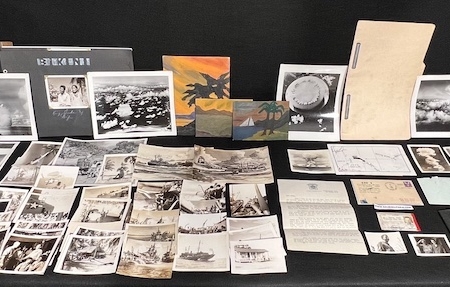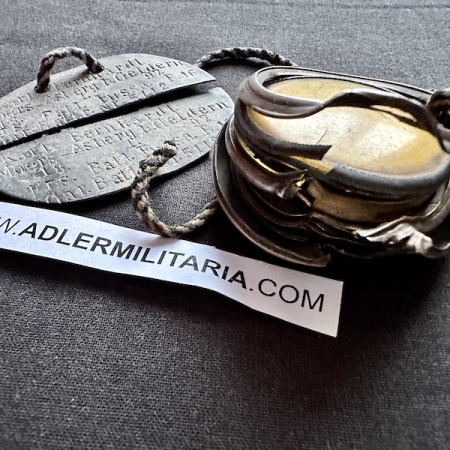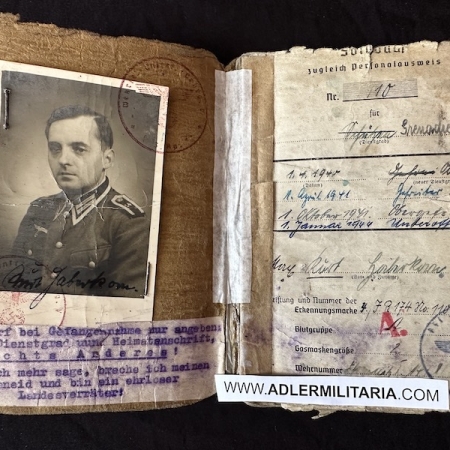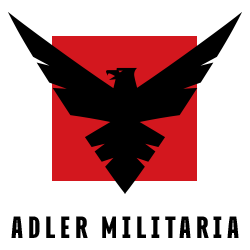Showing 28–33 of 33 resultsSorted by latest
-

WWII US Navy Collection – Mate 3rd Class J.V Lincoln x6 Emmy Awards – National Geographic Photographer – Admiral Chester Nimitz Personal Photographer – Operation Crossroads – Bikini Atoll – USS Mt.McKinley – Atomic Bomb – Super Rare Archive
$19,550.00WWII USN Personal Archive and Photographic Collection of Photographers Mate 3 rd Class John V. Lincoln who served as personal photographer during World War II “for Admiral Chester Nimitz even receiving a photo credit in National Geographic”. This one-of-a-kind Estate Archive is primarily focused on PhoM3c Lincoln’s experience photographing and establishing remote camera operations for the US Navy’s Operation Crossroads nuclear tests at Bikini Atoll in July 1946. For his time at Bikini Atoll Lincoln was stationed aboard USS Mt. McKinley AGC-7. The absolutely stunning archive tells the story of Joint Task Force One Operation Cross Roads Photo Unit One from the time they arrived at Bikini, interaction with Chief Juda and the Bikinian Islanders, relocation of the island natives, establishment of naval operations, and ultimately the Able & Baker Shots – Two Tests: the first being an airburst event over the target fleet, second an underwater detonation utilizing an LSM modified with drop through and crane. The target fleet was a large assembly of surplus and captured ships to be used for the test; including, Imperial Japanese Navy Nagato, German Kriegsmarine Prinz Eugen, and the venerable USS Saratoga among 98 ships brought to the lagoon for the operation. Lincoln’s archive is an assembly of personal photographs taken and developed, US Navy Official Photos, his Identification Card for Operations Crossroads, Diaries, Letters, Navy First Day Cover, an Article Written for National Geographic, some other press photos and his war time photos from the end of WWII in the Pacific. Highlights of the Collection include numerous photos on Bikini Atoll, the Islanders, numerous different angles of both Able; Baker, the attempt to “clean” the target fleet before the Baker test, letters, two diaries with various notes and entries, plus personal art done of Bikini Atoll. These pieces were originally contained in an album which fell apart – covers remain. Not sure who John Verner Lincoln was? Well… John Verner Lincoln (b. 22 Oct 1926 – d. 14 Oct 1997) “was a man before his time, one of the first to make his living capturing live action on film and, by all accounts, one of the best at his craft. He was a descendent of the Abraham Lincoln family and a look-alike for the man on the $5 bill. He built a tremendous resume over the course of his career, including six Emmy awards. He filmed presidents and popes, Super Bowls and superstars, soap operas and sitcoms. He recorded on tape, and later on film, the first and last episode of the Ed Sullivan Show. Soviet leader Nikita Kruschev first visit to the United States, the missions to the moon, the famous White House tour with Jacqueline Kennedy, and thirty years of the Masters Golf Tournaments. Hilda Lincoln recalled her husbands rapport with Walter Kronkite who used to ask Mr. Lincoln for new jokes to add to his repertoire. She remembered the time he was tear gassed by the Chicago police during the riots there and the time the couple flew to the Caribbean islands for the taping of the soap opera. Search for Tomorrow. He was born and raised in Brooklyn, served his country in the United States Navy during World War II where he was the personal photographer for Admiral Chester Nimitz even receiving a photo credit in National Geographic.” (Obituary of John V. Lincoln) Photographic Archives related to Operation Crossroads Task Force One July 1946 are nearly nonexistent. This exceptional personal archive of a film and photographic legend is certainly to be one of the absolute best in private hands, the silver gelatin of the Able Shot is worthy of exhibition. A True Museum or University Grade Research Archive from a less known time in Mr. Lincoln’s career. *OBITUARY* John Verner Lincoln, seventy years of age, passed away on October 14, 1997 at Plainview-Northshore Hospital following a valiant battle with colon cancer. He was a man before his time, one of the first to make his living capturing live action on film and, by all accounts, one of the best at his craft. He was a descendent of the Abraham Lincoln family and a ;look-alike for the man on the $5 bill. He built a tremendous resume over the course of his career, including six Emmy awards. He filmed presidents and popes, Super Bowls and superstars, soap operas and sitcoms. He recorded on tape, and later on film, the first and last episode of the Ed Sullivan Show. Soviet leader Nikita Kruschevs first visit to the United States, the missions to the moon, the famous White House tour with Jacqueline Kennedy, and thirty years of the Master's Golf Tournaments. Hilda Lincoln recalled her husband's rapport with Walter Kronkite who used to ask Mr. Lincoln for new jokes to add to his repertoire. She remembered the time he was teargassed by the Chicago police during the riots there and the time the couple flew to the Caribbean islands for the taping of the soap opera ;Search for Tomorrow;. He was born and raised in Brooklyn, served his country in the United States Navy during World War II where he was the personal photographer for Admiral Chester Nimitz even receiving a photo credit in National Geographic. When he returned, he married Hilda in 1947 and they moved into an original Levitt house in Levittown the next year.He later moved to Syosset where Hilda still resides. He began work at CBS in the 1950s, before the invention of the videotape, where he quickly emerged as the top star; of live television, said friend and CBS co-worker, Fred Schutz. After his retirement in the late 1980s, he spent many afternoons at the Bird Sanctuary at Tobay Beach capturing colourful still images of the feathered creatures for his own enjoyment. He is survived by his wife, Hilda Lincoln; two sons, John and Alan Lincoln; and three grandchildren. He was the son of the late Verner C and Ruth Loretta Verry Lincoln.
-

WWII US Navy Estate – Flag Officer to Admiral Raymond Spruance – Fifth Fleet 1944/1945 – USS Indianapolis – Kamikaze Piston – With Diary – Original ‘Raising the Flag on Iwo Jima’ by Joe Rosenthal – Ultra Rare Museum/Archive Grade (Request further details)
One of a kind and personal U.S. Navy Archive of Lt. Cyrus Huie, USNR who served as the Flag Officer to Admiral Raymond Spruance, Fifth Fleet Commander in 1944 and 1945 during many of the critical campaigns of later World War Two in the Pacific. Admiral Spruance, often considered to the be one of the best US Admirals of WWII, Commanded US Naval Forces during many of the most crucial Battles of the Asiatic Pacific Campaigns including The Battle of the Philippine Sea, Task Force 16 at The Battle of Midway with Carriers Enterprise , Hornet, subsequently becoming Commander of Fifth Fleet in April 1944 Spruance preferred to use the heavy cruiser USS Indianapolis, named for his hometown, as his flagship. Spruance moved his flag to the old battleship USS New Mexico after USS Indianapolis was struck by a Kamikaze off Okinawa “March 31, 1945: Well we got it today. A Jap plane crashed aft our main deck and banged us up a bit. Can still move along but fresh water is no more and looks like we will have to move. Am getting things lined up for it. Pretty scary feeling when the plane hit, retired to Kerawa Retto, 1 man buried this aft. Adm 2 guests for dinner.”- Diary of Lt. Huie (Kerama Retto). When New Mexico was struck by two kamikazes on the night of 12 May 1945 an immediate search by Spruance staff found the Admiral manning a fire hose midship. Determining that New Mexico was not too badly damaged Spruance kept her as his flagship for the rest of the campaign. Admiral Spruance was calculating and cautious in contrast to Admiral Halsey who commanded the Third Fleet. Spruance was nicknamed “Electric Brain” for his acute ability to remain calm even in moments of supreme crisis a reputation only further bolstered by his successful tactics. “April 12, 1945: We caught a mean one today shot down three planes, one plane hit the (illegible) about 1000 yards from us, one hit the Fellars and two were coming right for us it seemed. This is pretty jittery business, and everybody is fairly nervous except the Admiral who keeps very calm throughout. At GQ again tonight with flares dropped and torpedo attacks, several exploded fairly close to the ship.” – Diary of Lt. Huie. After World War II Spruance went on to serve as President of the Naval War College and Ambassador to The Philippines. On his way to take his position as President of the Naval War College Spruance and his wife stopped in Little Rock, Arkansas to dine with and visit his old Flag Officer Lt. Cyrus Huie as described in a newpaper article within the archive. This extraordinary personal archive chronicles the later portion of the Asiatic-Pacific Campaign and heralds the well known accomplishments of Spruance aboard the USS Indianapolis and USS New Mexico during some of the fiercest fighting of World War Two. It tells a unique story from the perspective of a Navy Lieutenant who loved to sketch cartoons and play the accordion or ukulele but was apprehensive about his experience with daily air raids and the grim loss of life. Join us as we take a close and personal look through the lens of Flag Officer Lt. Huie and his archive of exceptional objects and history related to this discovery. This Museum Quality Archive tells the story of some of the most significant moments of US Naval History with priceless highlights including an aluminum piston head from a Japanese Kamikaze Aircraft, an original theater printed copy of the ‘Raising the Flag on Iwo Jima’ by Joe Rosenthal with a Passed by Censor stamp to the reverse, Lt. Huie’s personal desk top calendar diary with extensive entries Feb 1944 – July 1944, Photographs, Autographs, Intelligence Items, documents, maps, newspapers, souvenirs and more. The diary alone contains a near daily appearances of the who’s who of leadership in the Pacific including Admiral Nimitz, Halsey, Sharp, Kirkpatrick, Gillies, Hill, Hover, Reifsnider, General Erskine, Riley, Rocky, Worton, Col. Hogaboom, Secretary of the Navy Forrestall, Ernie Pyle, and Numerous Others. A full dossier including diary transcription with reference footnotes and inventory is available to qualified buyers upon request. Contact us today to discuss this Estate
-

WWII German Photograph – General Leo Geyr von Schweppenburg – Normandy 1944 – Wearing British Dust Glasses – Super Rare Photo
$265.00An amazing photograph, displaying him with dust glasses taken from the British Army. Geyr von Schweppenburg (2 March 1886 – 27 January 1974) was a German general during World War II who is noted for his pioneering stance and expertise in the field of armoured warfare.[2][3] He commanded the 5th Panzer Army (formalised as Panzer Group West) during the Invasion of Normandy, and later served as Inspector General of Armoured Troops. After the war, he was involved in the development of the newly-built German Army (Bundeswehr). Freiherr von Geyr was born in 1886 in Potsdam into the Prussian military aristocracy and descended from a family that had produced two Prussian field marshalls.[4] He joined the German Army in 1904. In World War I, he fought on several fronts and rose to the rank of captain. After the war, he remained in the army, becoming an Oberst in 1932 and a Generalmajor in 1935. From 1933 to 1937, he was a military attaché to the United Kingdom, Belgium and the Netherlands and resided in London. Promoted to Generalleutnant upon his return from London, he took command of the 3rd Panzer (armoured) Division in 1937.[5] World War II From 1 September to 7 October 1939, Geyr commanded the 3rd Panzer Division during the invasion of Poland, where it was the most numerically powerful Panzer Division, with 391 tanks.[6] For a victory at Kulm, he was praised on the battlefield by Hitler, who had visited the division in recognition for its achievements in Poland.[7] He was promoted to General der Kavallerie of the XXIV Panzer Corps on 15 February 1940. In 1940, he commanded the XXIV Panzer Corps in the Invasion of France. In 1941, in the invasion of the Soviet Union, Geyr’s XXIV Panzer Corps was part of General Heinz Guderian’s Second Panzer Army, and consisted of all of Guderian’s major tank units.[8] On 9 July 1941, he was awarded the Knight’s Cross of the Iron Cross as General der Panzertruppe.[9] By early November 1941, Geyr’s Panzer Corps commanded the 3rd, 4th, and 17th Panzer Divisions, the panzer regiment from the 18th Panzer Division, as well as the Infantry Regiment Großdeutschland, and spearheaded the advance of Army Group Centre during the Battle of Moscow.[8] From 21 July 1942, taking over from the court-martialed Georg Stumme,[10] to 30 September 1942, he was commanding General of the XXXX Panzer Corps, taking part in the fighting in the Caucasus. Geyr was relieved in a command cadre shakeup at the end of September 1942.[10] In the spring of 1943, Field Marshal Gerd von Rundstedt ordered Geyr to prepare a force of 10 Panzer and motorised infantry divisions. On 19 November 1943, Geyr’s command was formalised as Panzer Group West, which had responsibility for the training and formation of all armoured units in the west. The group of armoured divisions near Paris constituted the Germans’ main force of tanks in France. In the event of an Allied landing on the northern French coast, Panzer Group West was expected to counterattack northward and to halt the invasion force.[11] The Allied invasion of Normandy took place on 6 June 1944. By 8 June, Geyr had moved three panzer divisions northward against British and Canadian forces advancing on the town of Caen. On, Royal Air Force aircraft attacked his newly-established headquarters at La Caine in Normandy. Geyr was wounded and many of his staff officers were killed, which forced the cancellation of the counterattack.[12] Geyr’s reinforced tank units managed to prevent the British advance for another month, but he was nevertheless relieved of his command on 2 July after seconding Rundstedt’s request for Hitler to authorize a strategic withdrawal from Caen.[13][14][15] He was succeeded by Heinrich Eberbach on 4 July and served as Inspector General of Armoured Troops until the closing phase of the war
-
Sale!

WWII German Knights Cross Holder – Karl-Conrad Mecke – Raid on St Nazaire – 22 Marine Flak Regiment
$225.00Original price was: $225.00.$165.00Current price is: $165.00.An extremely desirable and rare postcard size photograph of Mecke with his Knights Cross, which he won during the British raid on St Nazaire, also known as the Greatest Raid of All. Knights Cross action: Awarded for his role in combating the British raid on St. Nazaire, Operation Chariot, on 28.03.1942. Due to the unusual behaviour of the British bombers it was Mecke who recognized the potential of a landing and put his troops on alert. His guns later opened fire on the British convoy despite their disguise as German vessels and also participated in the fight against the British landing forces.
-

WW1 German Solders ID Tag and “Battle-damaged” Pocket Watch – Karl Bernhardt – Ers.Batl Fuss. Gar. Batt Nr 5112 –
$695.00Incredible little group. The battle damage likely deflected shrapnel or a bullet. The German Dog Tag is marked with: Karl Bernhardt Born: 12.1.1897 Unit: Ersatz Batl Fuss Gar Batt Nr 5112 Research shows that Karl Bernhardt survived the war and died in his hometown of Moers in 1966 of ill health. Watch: Incased old watch, was hit and opened, his name and date of birth matching the tag are engraved inside the watch. When we took this apart to show you the internal system of the watch it began to move. We have a video of it and will be given to the next owner…
-

Wehrmacht Soldbuch – Unteroffizier Haberkorn – Grenadier Regiment 1120 – 553 Volksgrenadier Division Ardennes 1944 – Wounded fighting US Troops 1945 (Reserved)
$345.00Wehrmacht Soldbuch for NCO Kurt Haberkorn. Soldbuch opened in December of 1939 with Infanterie Regiment 174. In 1941 – Etra Südost / Wehrmachttransportleitung Südost On 01.11.1940 – set up in Vienna, the use of which is to be considered in connection with the dispatch of the German army mission to Romania, which began in October, and the increasing involvement of the Balkans in German military plans. It was initially responsible for the transport command in Ostmark, Bohemia and Moravia, the transport officer in Pressburg and the German border command in Regensburg. Location always Vienna Late 1944 / 1945 – Grenadier Regiment 1120 (553 Volksgrenadier Division) – Fought against: US ARMY – 79 US Infantry Division & 10 US Armoured Division near Oehringen/Schwaebish Hall 1945 553. Volksgrenadier division was created on 9 October 1944 by the renaming of the 553. Grenadier division in Lorraine. The 553. Grenadier division was originally formed as a Sperr division (blocking division) in Münsingen. The unit was composed of men from Württemberg. In September 1944, the 553rd was rushed to the Lorraine region of the western front and thrown into battle against the Allied troops advancing on the city of Nancy. During September 1120. Grenadier regiment of the division defended Forêt de Champenoux to cover the withdrawal of the rest of the division. The regiment had entrenched thoroughly, building a line of log-covered dugouts and foxholes ten or fifteen yards inside the forest. Within the shelter of the woods a few assault guns backed up the infantry and covered still more entrenchments. When the Americans attacked with tanks and infantry on 20 September, they were repulsed. Repeated attempts were made to push the 1120th Regiment out of their positions during the day, and the following day, but all were driven back. The Americans tried a prolonged artillery barrage to demolished the entrenchments, but even this was unable to dislodge the defenders. On 22 September, the Americans tried a combined attack with the 80th and 35th Infantry Divisions, supported by one combat command of the 6th Armoured Division and the Volksgrenadiers were finally pushed out of the forest. With the Americans now threatening both his flanks, the 553. GD’s commander, Oberst Erich Loehr pulled his division back. The division was pulled out of the line in October. The whole 553. Grenadier division had been worn down after a month’s hard fighting and had to be reinforced. The reinforcements it integrated were number of fortress and independent battalions in the area of Army Group D. Even with the addition of these groups, one regiment (the 1121st) was dissolved along with the 2nd Battalion of 1120. Grenadier regiment. While the US Third Army was advancing from Metz, the US Seventh Army was preparing to clear the Saverne Gap. In mid-November, the American 44th Infantry and the French 2nd Armoured Divisions started an advance aimed at taking Saarbourg. Among the defending units was the newly renamed 553. Volksgrenadier division. Another hard defensive battle began for the Volksgrenadiers. The Allied assaults ground down the German units until they were only shadows of their normal organisations. After Saarbourg fell to the US 44th Infantry Division on 21 November, the remnants of 553. VGD were pulled out and transferred to southern Alsace. During Operation Nordwind the division the division attacked alongside 10. SS-Panzerdivision from Gambsheim towards Haguenau. At the end of January, the High Command decided to pull the 553. VGD out of the line entirely and rebuild it once again. The division was re-established on 31 January 1945 in Pforzheim. The division was deployed in the 19. Armee sector on 20 March. The division surrendered to the Americans shortly thereafter in Württemberg. Awards: Wounds badge in Black , he was wounded twice and received no Silver badge due to the war ending. Soldbuch comments. Very nice piece of paper added to the front page, detailing that he is if the captured only allowed to say his name, rank and home address, anything else is dishonourable and guilty of treason against Germany. A rare late war unit, fighting in desirable and sought after battles. 10th Armoured – US Army Documentary about the fighting in Germany, also where Haberkorn was wounded. An interesting documentary covering the creating on the Volks Grenadier Divisions




